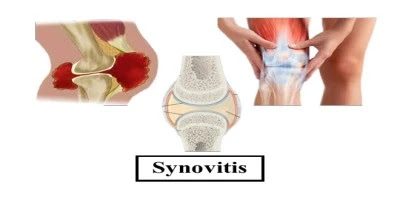Definition of SYNOVITIS
The synovium is a membrane underling of synovial joint such as knee joint, hip joint, when it is inflamed, then called synovitis. This membrane lines joints that have cavities known as synovial joints. This condition is usually painful, especially when the joint is moved. The joint usually swells due to the accumulation of synovial fluid.
Synovitis can occur in association with arthritis, as well as lupus, gout and other conditions. Synovitis is more common in rheumatoid arthritis than in other forms of arthritis, and thus may serve as a differentiating factor, although it is also present in many joints affected by osteoarthritis. In rheumatoid arthritis, fibroblast-like synoviocytes, highly specialized mesenchymal cells found in the synovial membrane, play an active and important role in synovitis. Long-term occurrence of synovitis can lead to joint degeneration.
Diagnosis of synovitis
In addition to the clinical picture (warm, red and swollen joints), the analysis of synovial fluid can help the diagnosis. This is a test that examines the lubricating fluid secreted by the synovial membranes. The test is useful in diagnosing some types of arthritis.
The test takes about half an hour and is usually done in a physician's chamber or hospital. No special preparations are necessary. The skin above the joint is cleaned with an antiseptic. A local anesthetic is usually applied. Using a thin needle, the doctor takes a sample of the fluid for analysis, including culture of the fluid if an infection is a possible diagnosis, and examination of crystals to diagnose gout or pseudo-gout...
If necessary, medication (usually a corticosteroid preparation) can be injected into the joint space with this needle after the sample has been taken.
Symptoms of synovitis
The signs and symptoms of synovitis depend on which area of the body is affected. Most people with synovitis usually experience these symptoms:
- The joint pain goes to very severe, sometimes
- Difficulty moving the affected area
- Edema
- Redness
- Heat
- Tissue thickening
- Increased fluid production
- Increased blood flow to the affected area
Synovitis Causes
Many things can cause synovitis. This condition may damage the joint and joint capsule when the body does not identify due to extra fluid of inflamed membrane. This can include things like articular cartilage damage, a labral tear, or a tear in the ligamentum teres.
Disease sometimes cause the synovitis. Rheumatic diseases, especially rheumatoid arthritis and systemic lupus erythematosus, can accidentally invade the synovium, leading to inflammation. It can be gone through gout, rheumatic fever, etc.
Rheumatoid arthritis includes synovitis. Rheumatoid arthritis, another autoimmune disorder of the joint, can cause inflammation of synovium, and that is why it is a very painful condition. Cells in the membrane divide and grow, and inflammatory cells enter the joint from other parts of the body.
Types of Synovitis
Septic synovitis: It is generally happened post-operative condition. When knee replacement has done or puncture by any external needle, synovitis can be happened. Because, a bacterium, staphylococcus is always stayed on the external part of skin, and they are very opportunist. They enter inside at the point of puncture or if the surgeon does not sterile the skin properly before operation.
Transient synovitis: It is generally seen in children or in puberty. When respiratory tracts are infected, it can be settled down to the hip joint. It is very painful and can not move the hip joint. Sometimes fever is the associated symptom.
Treatment of SYNOVITIS
Homeopathic approach is the best for synovitis
The main medicine is BRYONIA ALBA 6X: This medicine has a miraculous effect on synovitis and especially effect on the knee joint.
Another medicine is COLCHICUM AUTUMNALE 6: This medicine has a large sphere of action on synovial membrane, and good for the synovitis.
Synovitis goes naturally, sometimes without medication. If there is a pain, can do a cold compress.


Post a Comment